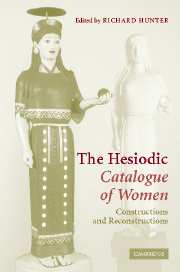Book contents
- Frontmatter
- Contents
- Notes on contributors
- Acknowledgements
- List of abbreviations
- Introduction
- 1 Ordering women in Hesiod's Catalogue
- 2 The beginning and end of the Catalogue of Women and its relation to Hesiod
- 3 Gods among men? The social and political dynamics of the Hesiodic Catalogue of Women
- 4 Heracles in the Hesiodic Catalogue of Women
- 5 Mestra at Athens: Hesiod fr. 43 and the poetics of panhellenism
- 6 A catalogue within a catalogue: Helen's suitors in the Hesiodic Catalogue of Women (frr. 196–204)
- 7 Pulp epic: the Catalogue and the Shield
- 8 The Megalai Ehoiai: a survey of the fragments
- 9 Ordered from the Catalogue: Pindar, Bacchylides, and Hesiodic genealogical poetry
- 10 The Hesiodic Catalogue and Hellenistic poetry
- 11 From genealogy to Catalogue: the Hellenistic adaptation of the Hesiodic catalogue form
- 12 The Hesiodic Catalogue of Women and Latin poetry
- 13 Or such as Ovid's Metamorphoses …
- Bibliography
- Index of passages discussed
- General index
12 - The Hesiodic Catalogue of Women and Latin poetry
Published online by Cambridge University Press: 22 September 2009
- Frontmatter
- Contents
- Notes on contributors
- Acknowledgements
- List of abbreviations
- Introduction
- 1 Ordering women in Hesiod's Catalogue
- 2 The beginning and end of the Catalogue of Women and its relation to Hesiod
- 3 Gods among men? The social and political dynamics of the Hesiodic Catalogue of Women
- 4 Heracles in the Hesiodic Catalogue of Women
- 5 Mestra at Athens: Hesiod fr. 43 and the poetics of panhellenism
- 6 A catalogue within a catalogue: Helen's suitors in the Hesiodic Catalogue of Women (frr. 196–204)
- 7 Pulp epic: the Catalogue and the Shield
- 8 The Megalai Ehoiai: a survey of the fragments
- 9 Ordered from the Catalogue: Pindar, Bacchylides, and Hesiodic genealogical poetry
- 10 The Hesiodic Catalogue and Hellenistic poetry
- 11 From genealogy to Catalogue: the Hellenistic adaptation of the Hesiodic catalogue form
- 12 The Hesiodic Catalogue of Women and Latin poetry
- 13 Or such as Ovid's Metamorphoses …
- Bibliography
- Index of passages discussed
- General index
Summary
COSMIC HISTORIES
Interest in the presence of Hesiod in Latin poetry has tended to focus first on what has been claimed as an Alexandrian – Callimachean and Aratean – image of Hesiod as an alternative model and authority to Homer, and secondly on the more direct use of the two Hesiodic works that survive in their entirety, the Theogony and the Works and Days. Depending on the focus, different images of Hesiod emerge. The ‘Alexandrian Hesiod’ licenses, it is suggested, a poetic practice defined as ‘not Homer’, characterised by a generically less elevated ambition and by a self-consciousness about the choices involved in a poetic career. A more direct recourse to the two Hesiodic works that survive today, paradoxically perhaps, encourages a seriousness of purpose and a socially and politically committed poetic voice, deriving primarily from the persona of the Works and Days, and a sublimity of subject-matter deriving primarily from the grand subject-matter of the Theogony, that both pull away from the ironic self-deprecation of the ‘Alexandrian Hesiod’. The diversity of the Hesiodic œuvre, and of the receptions of that œuvre, creates a space within which late Republican and Augustan poetry can trace its own paths over the slopes of Helicon. The Georgics in particular, as a self-consciously Ascraeum carmen (2.176), creatively exploits these different Hesiods: Callimachean and Aratean in its self-positioning use of the symbolic, Alexandrian ‘Hesiod’, as well as in its scholarly engagement with the detail of the Hesiodic text, but at the same time developing out of the earnest and mantic voice of the poet of the Works and Days a model for the Augustan uates.
- Type
- Chapter
- Information
- The Hesiodic Catalogue of WomenConstructions and Reconstructions, pp. 287 - 298Publisher: Cambridge University PressPrint publication year: 2005
- 3
- Cited by



